高中英语必修一Unit4Earthquakes听说课教案.doc
- 格式:doc
- 大小:114.00 KB
- 文档页数:4
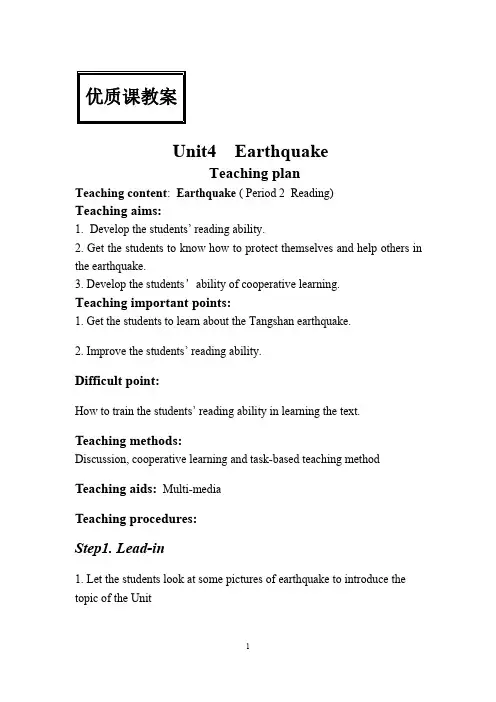
优质课教案Unit4EarthquakeTeaching planTeaching content:Earthquake(Period2Reading)Teaching aims:1.Develop the students’reading ability.2.Get the students to know how to protect themselves and help others in the earthquake.3.Develop the students’ability of cooperative learning. Teaching important points:1.Get the students to learn about the Tangshan earthquake.2.Improve the students’reading ability.Difficult point:How to train the students’reading ability in learning the text. Teaching methods:Discussion,cooperative learning and task-based teaching method Teaching aids:Multi-mediaTeaching procedures:Step1.Lead-in1.Let the students look at some pictures of earthquake to introduce the topic of the Unit2.Let the students enjoy a part of film of earthquake and get the studentsto answer the questions.⑴What happened in the film?⑵What are the people doing?3.Get the students to discuss the following question:(分组讨论)What do you think will happen before an earthquake? Step2.Fast reading(1)Let the students skim the text and divide the text into three parts.(2)Let the students find the top sentence of each paragraph and summarize the main idea of each partMain idea of each part:Part1(para.1):Strange things were happening before the earthquake.Part2(para.2-3):The disaster happened and caused a lot of loss. Part3(para.4):All hope was not lost.(Exchange your understanding of the passage with group members and work together to find the main idea of each part.培养学生归纳概括能力)Step3.Careful reading1.Read carefully and try to get more information to fill in the blanks.Strange thingsthe water in the village wells rose and fellthe well walls had deep cracks and smelly gascame outthe chickens and pigs were too nervous to eatmice ran out of the fields,looking forplaces to hidefish jumped out of the bowls andponds(用表格的形式表达出来,以锻炼学生的主学习能力和探究查读能力,使学生全面地了解地震的前兆。
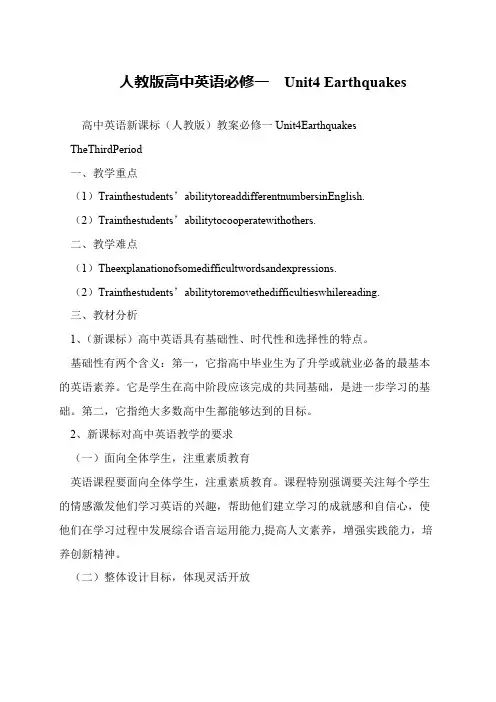
人教版高中英语必修一Unit4 Earthquakes
高中英语新课标(人教版)教案必修一Unit4Earthquakes
TheThirdPeriod
一、教学重点
(1)Trainthestudents’abilitytoreaddifferentnumbersinEnglish.
(2)Trainthestudents’abilitytocooperatewithothers.
二、教学难点
(1)Theexplanationofsomedifficultwordsandexpressions.
(2)Trainthestudents’abilitytoremovethedifficultieswhilereading.
三、教材分析
1、(新课标)高中英语具有基础性、时代性和选择性的特点。
基础性有两个含义:第一,它指高中毕业生为了升学或就业必备的最基本的英语素养。
它是学生在高中阶段应该完成的共同基础,是进一步学习的基础。
第二,它指绝大多数高中生都能够达到的目标。
2、新课标对高中英语教学的要求
(一)面向全体学生,注重素质教育
英语课程要面向全体学生,注重素质教育。
课程特别强调要关注每个学生的情感激发他们学习英语的兴趣,帮助他们建立学习的成就感和自信心,使他们在学习过程中发展综合语言运用能力,提高人文素养,增强实践能力,培养创新精神。
(二)整体设计目标,体现灵活开放。
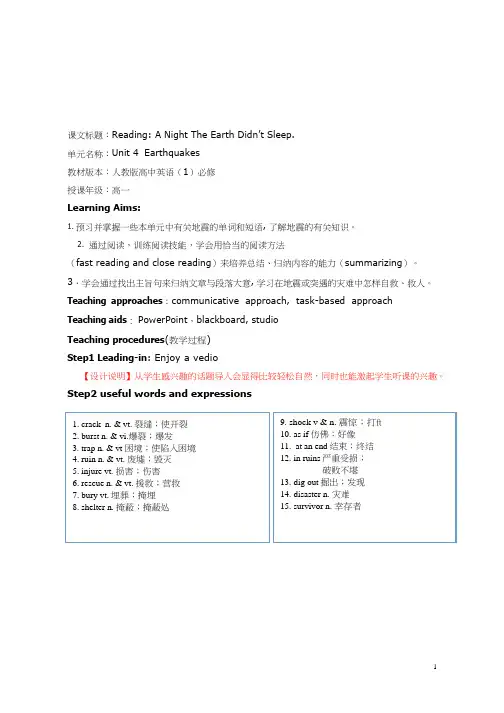
课文标题:Reading: A Night The Earth Didn’t Sleep.单元名称:Unit 4 Earthquakes教材版本:人教版高中英语(1)必修授课年级:高一Learning Aims:1.预习并掌握一些本单元中有关地震的单词和短语, 了解地震的有关知识。
2.通过阅读,训练阅读技能,学会用恰当的阅读方法(fast reading and close reading)来培养总结、归纳内容的能力(summarizing)。
3.学会通过找出主旨句来归纳文章与段落大意, 学习在地震或突遇的灾难中怎样自救、救人。
Teaching approaches:communicative approach, task-based approach Teaching aids:PowerPoint,blackboard, studioTeaching procedures(教学过程)Step1 Leading-in: Enjoy a vedio【设计说明】从学生感兴趣的话题导入会显得比较轻松自然,同时也能激起学生听课的兴趣。
Step2 useful words and expressions【设计说明】单词是基础,复习巩固生词为下一步阅读扫清障碍。
Step3 Fast-readingTry to get the structures of the passage main idea of the text .【设计说明】旨在锻炼学生快速搜索信息的能力。
跳读找出文章的主体大意及各段的主题,这样设计是为让学生了解、抓住本文的主题思想,为下一步细读做准备。
Step4 Careful readingPart 1 Before the earthquake: the signs【设计说明】文章较长,采取分段学习,课文层次清晰,学生自读与听力相结合,能帮助学生理解与提高听力水平,通过与搭档相互核对答案同时培养了学生合作学习的意识。
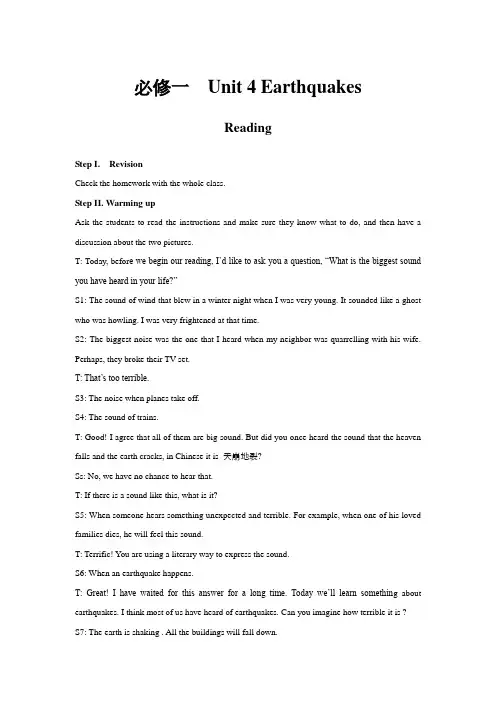
必修一Unit 4 EarthquakesReadingStep I. RevisionCheck the homework with the whole class.Step II. Warming upAsk the students to read the instructions and make sure they know what to do, and then have a discussion about the two pictures.T: Today, befor e we begin our reading, I’d like to ask you a question, “What is the biggest sound you have heard in your life?”S1: The sound of wind that blew in a winter night when I was very young. It sounded like a ghost who was howling. I was very frightened at that time.S2: The biggest noise was the one that I heard when my neighbor was quarrelling with his wife. Perhaps, they broke their TV set.T: That’s too terrible.S3: The noise when planes take off.S4: The sound of trains.T: Good! I agree that all of them are big sound. But did you once heard the sound that the heaven falls and the earth cracks, in Chinese it is 天崩地裂?Ss: No, we have no chance to hear that.T: If there is a sound like this, what is it?S5: When someone hears something unexpected and terrible. For example, when one of his loved families dies, he will feel this sound.T: Terrific! You are using a literary way to express the sound.S6: When an earthquake happens.T: Great! I have waited for this answer for a long time. Today we’ll learn somethin g about earthquakes. I think most of us have heard of earthquakes. Can you imagine how terrible it is ?S7: The earth is shaking . All the buildings will fall down.S8: Many people will die. And perhaps many children will lose their parents.T: Yeah, earthquakes are disasters to everybody. Now look at the two pictures of Tangshan and San Francisco. Can you describe what you see in the pictures?S1: Tangshan is a beautiful city. It has beautiful gardens, broad roads and some tall buildings.S2: From the picture of San Francisco, I can see that it is a very big city. There are many tall buildings thickly standing on the earth. I think the population of the city is very large.T: Good! What will happen if there has been a big earthquake in these two cities? Work in pairs and discuss it. Then I’ll ask so me of you to show your opinion.Step III.Pre-readingThere are two questions in this part. Both are very interesting. The first one can more or less reveal the students’ values; while the second one can enlar ge their imagination. No matter what their answers are, as long as they have given careful thoughts to the situations, their answers should be good.T: Now, let’s look at the pictures. What are the predictions of an earthquake?S1: Before an earthquake animals will become nervous. Cows, pigs, horses and dogs will be upset. And people can see mice running about. If the earthquake happens during winter, people can even see snakes.T: Terrific! Where did you get this knowledge?S1: From geography. I like it.T: good. Sit down please.S2: Madam, I don’t know the meaning of the picture with two women.T: It doesn’t matter. You will know it soon after reading our text. OK. Imagine there is an earthquake now, and your home is shaking, at this moment you have no time to take any other things but one, what will it be?S3: I’ll take all my money. People can’t live without money.S4: I will take as much water as possible. Because it is said that people can keep alive for nearly 7 days by drinking without any foodS5: I n that case, I’d rather take some apples, so that besides drinking, I can also eat.S6: I will carry my grandma. She is my most loved person in this world. She brought me up.T: What a dutiful child you are! I’m very glad to hear that. Sit down please! It seems that all ofyou know what you should do during an earthquake. OK. Let’s read our text, and see what it tells us.Step IV.ReadingIn this part, teacher should ask the students to read the passage quickly for the first time to get the general idea of the passage. Ask them to pay attention to the first sentence of each paragraph. This can help them finish exercise3 in Comprehention. It is about the main idea of each paragraph. Then ask them to read the text again carefully to obtain some details. Before reading for the second time, show some questions on the screen, and let the students read the questions first. These questions can guide them to have a good understanding about the text. They can also make preparations for Exs1-2, which are about details.SkimmingT: At first I’d like to read the text quickly to get the general idea of the article. While reading, you should pay attention to the sentence of each paragraph.T: Have you got the general idea of the text?Ss: Yes.T: What is it?S1: There is no quick answer to this question. Are you suggesting us that the general idea is the mixture of the first sentences of each paragraph?T: Sure.S1:OK. That’s easy. The main idea of the passage is some signs of the earthquake, and what would happen during the quake.T: Good, sit down please. In fact, while we are answering the questions, we have involved the sequence, the functional item for this unit. (Teacher writes the word on the blackboard) Do you understand the meaning of the word?Ss: No.T: Sequence means the order of the events. It can tell us which event happens first, and which happens later. Do you know the sequence that is used in our text?S3: Yes. At first, the text tells us something that happened before the quake, then it tells us the things that happened during the quake and at last it tells us the things that happened after the earthquake.T: Quite right! Now please look at the screen, these are the first sentences of each paragraph. Read them and think if they are the main idea of the text. If necessary, you may make some changes to make more exact.Teacher shows the screen and gives a little time to think it over.1.Strange things were happening in the countryside in the northeast Hebei.2.The disaster happened and caused a lot of loss.3.All hope was not lost.Careful readingT: Now, it’s time for us to read the text carefully. But before reading, you should read some questions first. These questions may help you get some information quickly and easily. Now look at the screen, and read the questions.Show on the screen1.What natural signs of a coming disaster were there?2.Can you think of some reasons why these signs weren’t noticed?3.What events probably made the disaster worse?4.What situations probably made the disaster worse?5.How were the survivors held?Step V.Extension]Show the questions on the screen.1.From whose point of view are events described? How do you know?2.What is the mood of this passage? How is it created?3.Why do you think the writer chooses to express his feelings about the quake rather thansimply reporting what had happened?4.Why is the title A NIGHT THE EARTH DIDN’T SLEEP?5.What does the sentence “Slowly, the city began to breathe again.” mean?Answers:1.He uses third-person to describe the quake. His description is very objective. For example, thesecond sentence in the third paragraph. The writer says: “Everywhere they looked nearly everything was destroyed.” The writer uses they instead of we.2.The mood is serious and a bit sad. It is created by giving details of how many people and。
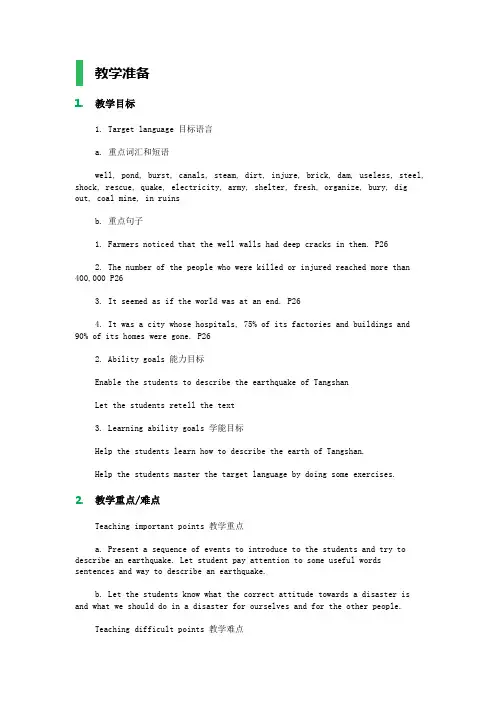
教学准备1. 教学目标1. Target language 目标语言a. 重点词汇和短语well, pond, burst, canals, steam, dirt, injure, brick, dam, useless, steel, shock, rescue, quake, electricity, army, shelter, fresh, organize, bury, dig out, coal mine, in ruinsb. 重点句子1. Farmers noticed that the well walls had deep cracks in them. P262. The number of the people who were killed or injured reached more than 400,000 P263. It seemed as if the world was at an end. P264. It was a city whose hospitals, 75% of its factories and buildings and 90% of its homes were gone. P262. Ability goals 能力目标Enable the students to describe the earthquake of TangshanLet the students retell the text3. Learning ability goals 学能目标Help the students learn how to describe the earth of Tangshan.Help the students master the target language by doing some exercises.2. 教学重点/难点Teaching important points 教学重点a. Present a sequence of events to introduce to the students and try to describe an earthquake. Let student pay attention to some useful words sentences and way to describe an earthquake.b. Let the students know what the correct attitude towards a disaster is and what we should do in a disaster for ourselves and for the other people.Teaching difficult points 教学难点Teach the students how to appreciate an article.3. 教学用具课件4. 标签Unit 4 Earthquakes教学过程StepⅠLead-in (4 minutes)Greeting each otherT: As we all know, in our daily life, many strange things may happen, doyou think so? Can you tell me what strange things may happen?StepⅡWarming-up (6 minutes)Let the students look at some pictures and think about this question: Howmany natural disasters do you know? And then introduce Sichuan and Tangshanearthquakes to the students.StepⅢPre-reading (3 minutes)There is one question in this part. It is very interesting. It can enlargetheir imagination. No matter what their answers are, as long as they have givencareful thoughts to the situations, their answers should be good.T: Imagine there is an earthquake now, and your home is shaking, at thismoment you have no time to take any other things but one, what will it be?OK. Let’s read our text, and see what it tells us.Step ⅣReading (20 minutes)Fasting Reading (5 minutes)T: At first I’d like you to read the text quickly and silently to get thegeneral idea of the article. While reading, you should pay attention to thefirst sentence of each paragraph.Two or three minutes laterT: Have you found the general idea of the text? T: What is it? And thenask the students to match the main idea of each part.Careful reading (15 minutes)T: Now, it’s time for us to read the text carefully. But before readingyou should readsome sentences first. These sentences may help you get some informationquickly and easily. Now look at the screen, and read the sentences. (Show onthe screen.)Ask them to find out the numbers of each sentence.T: the numbers can tell us the destruction of earthquakes and also canmake us gain more information of Tangshan earthquake.Step ⅤPost reading(8 minutes)Retell the passage (show a short summary of the text on the screen). Askthe students to use some words or phrases to finish the short summary.Step ⅥDiscussion (5 minutes)Ask the students to discuss this question thisquestion: What should we do to protect ourselves if an earthquake happened?。
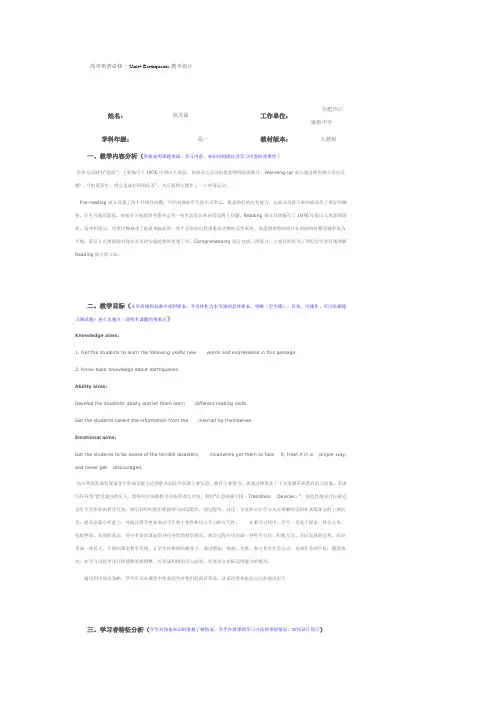
高中英语必修一Unit4 Earthquakes教学设计合肥庐江姓名:陈先銀工作单位:盛桥中学学科年级:高一教材版本:人教版一、教学内容分析(简要说明课题来源、学习内容、知识结构图以及学习内容的重要性)本单元话题为“地震”,主要描写了1976年唐山大地震,各项语言活动也都是围绕地震展开。
Warming-up 部分通过两张图片引出话题“一旦地震发生,将会造成怎样的危害”,为后面的主题作了一个热身运动。
Pre-reading 部分设置了两个开放性问题,目的是增加学生的生活常识,提高他们的应变能力。
这部分为接下来的阅读作了很好的铺垫,学生可通过套乱,参阅有关地震的书籍并运用一些生活常识来回答这两个问题。
Reading 部分具体描写了1976年唐山大地震的震前、震中和震后。
作者详细描述了地震来临前的一些不正常的自然现象及动物的反常表现;地震的来势汹汹并在顷刻间将整座城市夷为平地;震后人们勇敢面对现实并及时实施抢救和重建工作。
Comprehending 部分包括三组练习,主要目的是为了帮助学生更好地理解Reading部分的文章。
二、教学目标(从学段课程标准中找到要求,并具体化为本节课的具体要求,明晰(学生懂)、具体、可操作、可以依据练习测试题)重点及难点(说明本课题的重难点)Knowledge aims:1. Get the students to learn the following useful new words and expressions in this passage.2. Know basic knowledge about earthquakes.Ability aims:Develop the students’ ability and let them learn different reading skills.Get the students collect the information from the internet by themselves.Emotional aims:Get the students to be aware of the terrible disasters, meanwhile get them to face it, treat it in a proper way, and never get discouraged.高中英语新课程要求学生的阅读能力达到能从阅读中获取主要信息,抓住主要情节,能通过情景及上下文猜测不熟悉的语言现象。
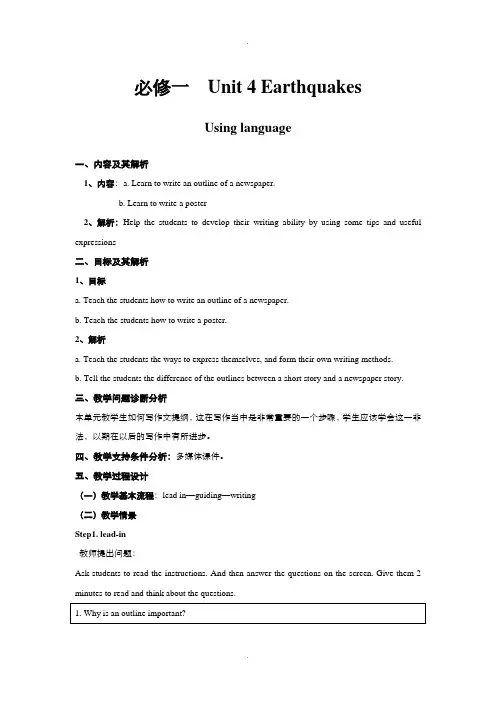
必修一Unit 4 EarthquakesUsing language一、内容及其解析1、内容:a. Learn to write an outline of a newspaper.b. Learn to write a poster2、解析:Help the students to develop their writing ability by using some tips and useful expressions二、目标及其解析1、目标a. Teach the students how to write an outline of a newspaper.b. Teach the students how to write a poster.2、解析a. Teach the students the ways to express themselves, and form their own writing methods.b. Tell the students the difference of the outlines between a short story and a newspaper story.三、教学问题诊断分析本单元教学生如何写作文提纲,这在写作当中是非常重要的一个步骤,学生应该学会这一非法,以期在以后的写作中有所进步。
四、教学支持条件分析:多媒体课件。
五、教学过程设计(一)教学基本流程:lead in—guiding—writing(二)教学情景Step1. lead-in教师提出问题:Ask students to read the instructions. And then answer the questions on the screen. Give them 2 minutes to read and think about the questions.设计意图:通过提问,激发学生写作的兴趣。
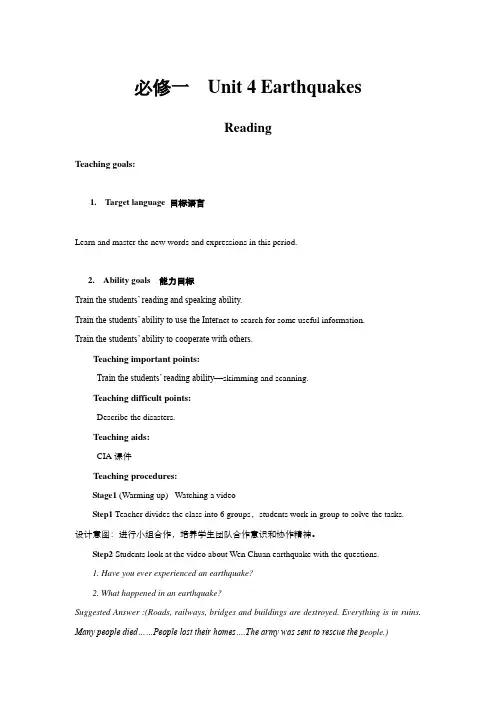
必修一Unit 4 EarthquakesReadingTeaching goals:1.Target language 目标语言Learn and master the new words and expressions in this period.2. Ability goals 能力目标Train the students’ reading and speaking ability.Train the students’ ability to use the Inter net to search for some useful information.Train the students’ ability to cooperate with others.Teaching important points:Train the students’ reading ability—skimming and scanning.Teaching difficult points:Describe the disasters.Teaching aids:CIA课件Teaching procedures:Stage1 (Warming up) Watching a videoStep1 Teacher divides the class into 6 groups,students work in group to solve the tasks.设计意图:进行小组合作,培养学生团队合作意识和协作精神。
Step2 Students look at the video about Wen Chuan earthquake with the questions.1. Have you ever experienced an earthquake?2. What happened in an earthquake?Suggested Answer :(Roads, railways, bridges and buildings are destroyed. Everything is in ruins. Many people died……People lost their homes….The army was sent to rescue the p eople.)3. How many several terrible earthquakes do you know in the world?Suggested Answer:(Japanese earthquake-- March 11st, 2011 Gansu yushu earthquake-- April 14th, 2010 Haiti earthquake-- January 12nd, 2010 Sichuan wenchuan earthquake-- May 12nd, 2008 Hebei Tangshan earthquake -- July 28th, 1976)设计意图:利用视频导入,一方面能激发学生的学习兴趣和背景知识,另一方面为下文的主题做好铺垫。
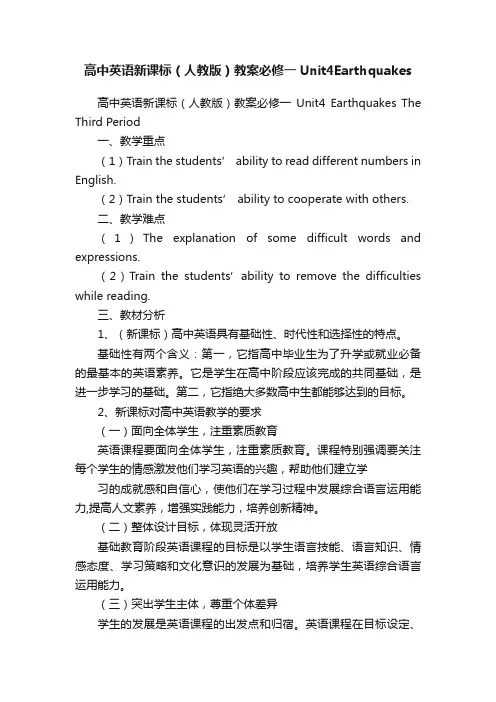
高中英语新课标(人教版)教案必修一Unit4Earthquakes高中英语新课标(人教版)教案必修一Unit4 Earthquakes The Third Period一、教学重点(1)Train the students’ ability to read different numbers in English.(2)Train the students’ ability to cooperate with others.二、教学难点(1)The explanation of some difficult words and expressions.(2)Train the students’ability to remove the difficulties while reading.三、教材分析1、(新课标)高中英语具有基础性、时代性和选择性的特点。
基础性有两个含义:第一,它指高中毕业生为了升学或就业必备的最基本的英语素养。
它是学生在高中阶段应该完成的共同基础,是进一步学习的基础。
第二,它指绝大多数高中生都能够达到的目标。
2、新课标对高中英语教学的要求(一)面向全体学生,注重素质教育英语课程要面向全体学生,注重素质教育。
课程特别强调要关注每个学生的情感激发他们学习英语的兴趣,帮助他们建立学习的成就感和自信心,使他们在学习过程中发展综合语言运用能力,提高人文素养,增强实践能力,培养创新精神。
(二)整体设计目标,体现灵活开放基础教育阶段英语课程的目标是以学生语言技能、语言知识、情感态度、学习策略和文化意识的发展为基础,培养学生英语综合语言运用能力。
(三)突出学生主体,尊重个体差异学生的发展是英语课程的出发点和归宿。
英语课程在目标设定、教学过程、课程评价和教学资源的开发等方面都突出以学生为主体的思想。
课程实施应成为学生在教师指导下构建知识、提高技能、磨砺意志、活跃思维、展现个性、发展心智和拓展视野的过程。
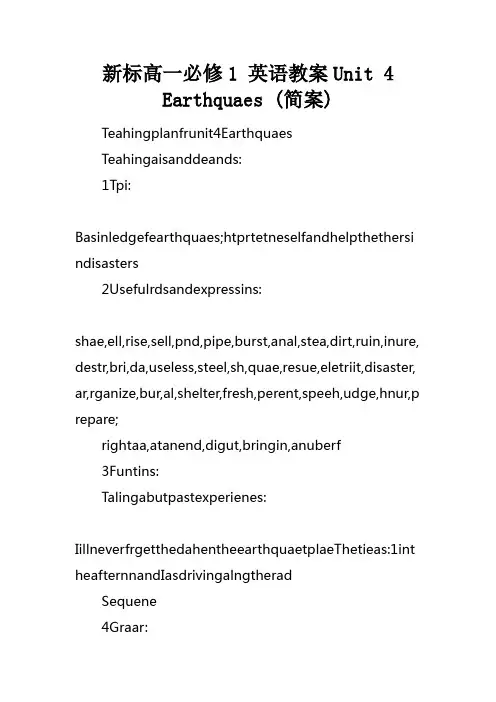
新标高一必修1 英语教案Unit 4Earthquaes (简案)Teahingplanfrunit4EarthquaesTeahingaisanddeands:1Tpi:Basinledgefearthquaes;htprtetneselfandhelpthethersi ndisasters2Usefulrdsandexpressins:shae,ell,rise,sell,pnd,pipe,burst,anal,stea,dirt,ruin,inure, destr,bri,da,useless,steel,sh,quae,resue,eletriit,disaster, ar,rganize,bur,al,shelter,fresh,perent,speeh,udge,hnur,p repare;rightaa,atanend,digut,bringin,anuberf3Funtins:Talingabutpastexperienes:IillneverfrgetthedahentheearthquaetplaeThetieas:1int heafternnandIasdrivingalngtheradSequene4Graar:Theattributivelause由that,hih,h,hse引导的定语从句Thenuberfpeplehereilledrinuredreahedrethan400,000 ItasheardinBeiinghihisnehundrediletersaarersbuiltsheltersfrsurvivrshseheshadbeendestred Teahingpredures:Perid1Step1aringupSsdisussandansersequestins:hihfthefllingaausepeplethegreatestdaage?AearthquaeBtphnfldDdrught2Iagineurhebeginstshaeanduustleaveitrightaauhavetie ttaenlnethinghatillutae?h?Step2Pre-readingSsdisussandanser:Dunhatuldhappenbefreanearthquae?2hatanedteepurselvessafefranearthquae?3DunanthingabutTangshanEarthquaein1976?Step3ReadingSiingandfindtheanserstthefllingquestins:ahathappened?bhenandheredidithappen?2Ssreadagainandfillinthefllingfr:TiehathappenedBefretheearthquaeells:Anials:Lightsandsund:aterpipes:hiletheearthquaeHuses,radsandanals:Hardhillsfr:Thela rgeit:Thepeple:AftertheearthquaeHspitals,fatriesandbuildings:Thegru nd:Das:Railatras:Anials:ells:3Ssreadthehlepassageagainandgettheainideasfeahpar t:Part1ThenaturalsignsfaingearthquaePart2ThedaageftheitaftertheearthquaePart3ThehelptthesurvivrsStep4prehendingSsfinishEx1and2npage27StepAssignentSurftheinternetandgetreinfratinabuttheearthquae2RetellthetextPerid2Step1aringupSssharereinfratinabuttheearthquae2AsseSstretellthetextbusingtheirnrdsStep2Languagepintslie–la-lain:tbe,reainrbeeptinaertainstate处于某种状态ThevillagelainruinsafterthearTheseahineshavelainidlesinethefatrlsed2inruins:severeldaagedrdestred损坏anearthquaeleftthehletninruinsHisareerisinruins3nuber:aquantitfpeplerthings数量;数量Thenuberfpepleapplinghasinreasedthiseareerefifteeninnuberanuberf:altfIhaveanuberfletterstriteAlargenuberfpeplehaveapplied4inure:thurtneself/sb/sthphsiall受伤Hefellffthebileandinuredhisarreah:tahieverbtainsth达到;达到;取得u’llunderstandithenureahageAtlastereahedadeisin6resue:anatfresuingrbeingresued搭救;解救AresueteaistringtreahthetrappedinesResue:tsaversetfreefrhar,indanger,rlss解救;救出Theresuedtheanfrdrning7trap:inaplaefrhihneantstesapebutannt困住;陷于绝境Theeretrappedintheburninghtel8all…nt…=ntall…:sebutntall一些;但不是全数Ntallthegirlsleft=nlseftheleftearlNtallthehildrenarenis=Sefthehildrenarentnis全数否定应用:nnef…NnefuserealledtgthereNnefthesereprtsisverhelpfulStep3learningabutlanguageSsfinishEx1,2and3npage27and282TeaherhestheanserandgivetheSssehelpifthehavesedif fiultStep4assignentFinishbEx1npage632SstrtreebertheusefulrdsandexpressinsbheartsPerid3Step1aringupSsreadthepassageagainandtrtfindthesentenesithattrib utivelausesegrersbuiltsheltersfrsurvivrshseheshadbeendestred Step2AttributivelauseGiveSsresentenesandlettheSstfindthestruturesftheattri butivelause2Ssdseexerisesabuthtusethat,hih,hrhse3SsfinishEx2npage28Seaterialsabutattributivelause:关系代词引导的定语从句关系代词所代替的先行词是人或物的名词或代词,并在句中充当主语、宾语、定语等成份。
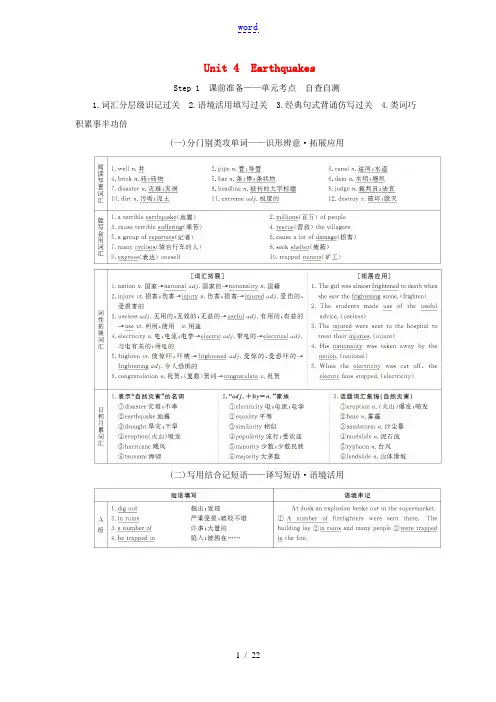
Unit 4 EarthquakesStep 1 课前准备——单元考点自查自测1.词汇分层级识记过关2.语境活用填写过关3.经典句式背诵仿写过关4.类词巧积累事半功倍(一)分门别类攻单词——识形辨意·拓展应用(二)写用结合记短语——译写短语·语境活用(三)仿写活用练句式——经典句型·仿写背诵Step 2 课堂探究——核心考点点点突破1.重点难点考点学通练透2.归纳总结拓展开阔视野3.方法规律技巧权威点拨4.面面俱到打创高效课堂第一时段Warming up & Reading1.burst vi.爆裂;爆发;突然迸发;冲;闯n.突然破裂;爆发[教材原句] In the city, the water pipes in some buildings cracked and burst.在市内,有些建筑物里的水管出现裂缝并爆裂开来。
(1)burst in/into 闯入;突然破门而入(2) ⎭⎪⎬⎪⎫burst out crying/laughing burst into tears/laughter 突然哭起来/笑起来 burst with anger 勃然大怒单句语法填空①On hearing the news, Mary burst ________ laughter while Lucy burst out ________(cry).②Last night the room ____________(burst) into but nothing was taken away.[答案] ①into; crying ②was burst2.ruin n .[U ]毁灭;毁坏;崩溃;[常用复数]废墟;遗迹 vt.(使)毁坏;成为废墟[教材原句] In fifteen terrible seconds a large city lay in ruins .在可怕的15 秒内,一座大城市成了废墟。
人教版高一英语必修unit4 Earthquake全单元教案Warming-up & ListeningTeaching goals:1. Get a general idea of earthquakes and some other natural disasters;2. Train students’ listening ability and try to improve their pronunciation;3. Know the damage that an earthquake and other disasters could bring about and ways to reduce the losses of an earthquake.Teaching important points:Train the students’ listening ability and improve pronunciation. Teaching aids:A tape recorder; the blackboard; CIA课件Teaching procedures:Step1. Lead-in----video of different natural disastersT: Our hometown is a place full of a kind of disasters. What is it?Typhoon, earthquake, hurricane tsunami, flood, tornado, drought…are all called natural disasters.Q. what damage will they bring about?---- everything in ruins/ death/ losses…Step2. Introduction of Earthquakes (Let students get the general idea of earthquake)Q: what do you know about earthquake? What causes quakes and where do they often happen? How to predict an earthquake? Q: How to avoid being hurt?? ----through gamesQ: Have you heard of any land earthquakes?----Two pictures in warming-up: Tangshan Earthquake and San Francisco Earthquake.Q: What do you know about these two earthquakes?Step3: Listening1. Pre-listening----brief introduction of San Francisco EarthquakeQ: When did the quake happen?---- 1906Q: what damage did bring about?---- About 700 people died in the earthquake and the fires. And as many as 250,000 people lost homes…2. While-Listening----according to the exercises in the text book3. Post-listening----How can we reduce the damage of earthquake? What can we do?Step4: Homework ---- preview the reading “A Night the Earth didn’t Sleep” and learn new words of this unitReadingTeaching goals:1. Target language 目标语言Learn and master the new words and expressions in this period.2. Ability goals 能力目标Train the students’ reading and speaking ability.Train the students’ ability to use the Internet to search for some useful information.Train the students’ ability to cooperate with others.Teaching important points:Train the students’ reading ability—skimming and scanning.Teaching difficult points:Describe the disasters.Teaching aids:CIA课件Teaching procedures:Step1. Lead-inT: We have a visit to the museum of natural disasters, and you have learned about some brief introduction of most disasters. Today, I want to show you round the earthquake department, and I hope you will like it and learn some useful knowledge. Now let’s go.T: At the very beginning, I want to know how much you know about an quake.Q1: What would you take with you if a quake happened?Q2: The best way to save yourself is to know there will be a quake before it happens. What kind of signs can tell you that there is a quake?Q3: What kind of damage can an earthquake cause?S: buildings are destroyed; people are killed; families are broken…T: Let’s have a look at some pictures of such terrible site. (Pictures of quakes)T: (The last picture is monument of Tangshan quake.) Do you know what this is?Step2. Pre-ReadingT: 30 years ago, on the day July, the 28th, a terrible disaster suddenly happened, and the beautiful Tangshan was removed from the map. This is Tangshan quake. Does any body know something about Tangshan quake?T: Let’s read a news report about the famous quake.Step3. While-readingI. Skimming & scaringGet the students comprehend the passage quickly and accurately, and meanwhile help the students to form a good habit of reading.T: First please skim the passage fast to obtain/ get a general understanding of the whole passage. And underline the answers to the following questions. II. While reading, divide the whole passage into 3parts and find out the main idea of each part.Para.1 before the quakePara.2-3 during the quakePara.4 after the quakeII. Careful-readingRead the passage again and try to get more detailed information.T: Now let’s read the passage again and find more information. Join the correct parts of the sentences. (Turn to page 27, ex1)T: Now you have read the passage carefully, please put the sentences in order. Number each of these things during the Tangshan quake.(Turn to page 27, ex2) T: here are some more work for you. You can work in groups.T: Let’s watch some pictures, and comparing the old Tangshan, the Tangshan after quake, and the new Tangshan we see today.Step 4 Post-reading (discussing)T: After read the news report, and see so many pictures, what impresses you most? Why?Or what do you learn from such a disaster?(Self-rescue, environment protection, rebuilt, love and help)I: self-rescue (a video game)T: When in a quake, if you know some self-rescue skills, you may probably save yourself. If you want to know some of the skills, click here. (Link to the index)Let’s do little game to see how much you know about self-rescue.II. What did they suffer and feel?T: Can you understand what they suffer and what they feel after such a disaster?T: If you were one of the rescuers 30 years ago, what could you say and what can you do to comfort them? Or how could you help them?III. RebuildingT: we see that the new Tangshan has been set up. What is needed to rebuild Tangshan.IV: environment protectionT: nowadays there are more disasters than before. One of the reasons is that we pay more attention to our economy development than the earth we live. Look at these pictures. What can we students do to save the earth?T: Though the disasters destroy buildings, people’s lives, but it can not destroy the love among us.Step 5 Homework1. Find more news reports about earthquake.2. Write a piece of news about Tangshan. You can use the information in the passage.News WritingTeaching aims:1. Get students to learn how to write news;2. Train students the ability to cooperate with each other and to search for information;3. Learn more about Tangshan earthquake and honor the people of Tangshan.Teaching difficulties:1. How to make students learn writing in a more practical and effective way;2. How to help students understand the tips for writing. Teaching procedure:Step 1: Lead-in----The 30th anniversary of Tangshan earthquake (news)T: We have learnt the Tangshan earthquake. When did it happen? How many people died during the earthquake?Step 2: Prese ntation of students’ news writing(homework of last class) ----point out the mistakes in news writing according to three aspects T: You have finished the news writing of Tangshan earthquake, and now it’s time for you to show your project. Others have to point out the mistakes in his or her writing according to three aspects.----Three aspects: headline; content and languageT: What do you think of his or her writing? Is it a proper news writing? What have you done before your writing?Step 3: Tips for writing1. Preparation ---- an outlinePreparation: Choose a topic; decide what you want to say about the topic; Organize your ideas and write clearly.Outline: A headline; a list of main ideas; A list of important details 2. Headline⑵ characteristics of headlinesQ: what’s the characteristic of headlines?⑶ practice ---- write headlines for the following news according to the picture and information givenFlood relief efforts----The death toll on the Chinese mainland from Typhoon Kaemi has risen to 32, with at least 65 still missing. Local governments are sparing no efforts to carry out relief work.PLA celebrates 79th birthday----The Chinese People's Liberation Army is 79 years old, and the Defense Ministry has held a reception to celebrate.Quake hits Indonesian island----A moderate earthquake has struck near Indonesia's Nias island off northern Sumatra. The quake, with a magnitude of 5.6 struck just before 8.30 am, and was centered under the Indian Ocean, about 55 kilometers northwest of the main town on the island, Gunung Sitoli.Railway's impact on Tibetans----The Railway brings the remote Qinghai-Tibet plateau closer to the rest of the world. With people able to move in and out of the region more easily and the economic benefits the railway brings, the lives of Tibetans will never be the same again.3. Content---- How to organize your content of news⑴ Tips----Be clear of the content you want to mention; List your ideas; Write the most important thing in the beginning and the less ones in the following⑵ Practice----write the beginning of news according to the information and picture givenA woman;rifts on the wall;earthquake measuring 5.1degrees;Wen'an County, north China'sHebei Province;11:56 a.m. Tuesday, July 4, 2006;the quake’s epicenter --about 110kilometers from Beijing and 80 kilometers from Tianjin;casualty –not knownA woman points at the rifts on the wall of a village school after an earthquake measuring 5.1 degrees on the Richter scale jolted Wen'an County, north China's Hebei Province at 11:56 a.m. (Beijing Time) Tuesday, July 4, 2006. The quake was a shallow-focus one, with its epicenter being around 110 kilometers from Beijing and about 80 kilometers from Tianjin. No casualty was reported at press time.4. LanguageTips----clear; objective; brief; accurate; written English…Step 4: Appreciation of newsRadio----VOA news: “Aid for tsunami victims”News report----“Tangshan Quake 30th Anniversary”Step 5: Improvement of students’ writing ----Improve your news writing about Tangshan earthquakeUsing Language----Reading, writing and speakingTeaching Aims:1. Enable the students to make a speech2. Let the students enjoy some famous speechesTeaching Important and Difficult Points:1. Review something about disasters2. How to make a speechTeaching Methods:1. Individual work2. group workTeaching Aids: Computer, blackboardTeaching Procedures:Step 1 Lead-in(Teacher shows a series of pictures of some disasters on the screen, let the students talk about their feelings or anything they feel about the pictures.)(The pictures are: fire, hurricane, t yphoon, tsunami, earthquake…)T: In this unit, we learn a lot about disasters. We know disaster is not a good thing to us. We often feel sad or sorry if a disaster happens. T: Right now, you have just seen some of the disasters. Do you feel worried about these refugees?Ss: Yes.Step 2 DiscussionT: Yes, everybody will feel sorry for them. But who is the most worried people when a disaster happens?Ss: families and friends / government and president / ……..T: Suppose, there is an earthquake happen somewhere in China, and you have a friend happens to be there. You are very worried. What will you do when you hear that an earthquake happens there? (Let the students discuss with their partner)Ss: I will feel very worried. I will make sure my friend is Ok as soon as possible. I will make a call to see if he is Ok.T: Again, suppose you are a president of a country, and an earthquake happens in your country. What will you do?Ss: It is my duty to comfort the refugees and the society. So first I will make a live speech to the whole country, telling my people that I know it and I will try my best to organize the rescue work and the rebuilding work after the earthquake.T: Yes, you are very clever. In fact, a real president will do just as you said ----- to make a speech. Now just let’s listen to a real speech madeby President Bush after a big earthquake hit India on the first day of New Year.(Play the tape record for the students)Step 3 SpeechT: Right now we’ve just listened to a speech made by Presid ent Bush. Do you know something about how to make a speech? Can you tell me when should we make a speech?Ss: a speech competition / election / the beginning of a new year / the opening of some activity / anniversary…..T: Yes, people need to make speeches at those times. Then do you know how to make a speech? What should we contain when we make a speech?Ss: Introduction: Give a strong first impression & preview your speech Body: Explain your ideas and support themConclusion: Review your speech and leave a lasting finalimpression.Step 4 TextT: It seems that you know a lot about making a speech. I remember we say that we may need to make a speech when it is some important anniversary. T: You know 2006 is the 30th anniversary of Tang Shan Earthquake. Here is an invitation, inviting you to make a speech about it. You can look at the letter on your text book.T: You can include these points in your speech;1. thank Mr Zhang Sha and the city government for inviting you to speak2. thank the visitors, especially the survivors3. thank those who worked hard to save survivors4. list some of the things the workers did to help the survivors5. thank those who worked hard to build the city6. describe your feeling about the city, which is known as the “Brave City of China”.7. encourage the people to be always proud of their city.8. thank the visitors for listening to your speech.T: So try to give a speech, using these points. Now I will give you 5miniutes to finish the speech.(after 5 minutes)Step 5 Speech contestT: Times up. Have you finished your speech? Ok, I think it is time for us to hold a speech contest. We have 4 groups in our class. Each group, please choose one contestant to represent your group and join the class speech contest. …, …and … will be the judges.(Ask each group to give a speech and the chosen judges will choose the winner.)T: Congratulations to the winner! Step 6 ConclusionT: In this lesson we learned a lot about speech and we also made a speech by ourselves. So do you know how to make a speech now?T: At the end of the class, let’s enjoy a very famous speech in human history.(Abraham Lincoln Gettysburg Address)六.评估与反馈----according to the “Summing Up” in unit 4。
高一英语新课标Unit 4 Earthquakes教案I. 单元教学目标Know basic knowledge of earthquakes.Know how to protect oneself and help others in disasters.Write some passages about earthquakes.Write a newspaper outline.Learn to use the Attributive Clause.II 目标语言1. Talking about past experiencesI will never forget the day when the earthquake took place. The time was 5:15 in the afternoon and I was driving along the road.2. SequenceI asked a man standing next to me what had happened. Before he could answer, hundreds of bricks fell on him and he was killed. I thought the end of the world had come! Then I met a man who knew the way to a boat, and we ran in its direction. I saw many frightened cows rush up Market Street and drop into a great crack ground.III 词汇1. 四会shake,well,rise,smelly,pond,pipe,burst,canal,steam,ruin,injure,destroy,brick,da m,useless,steel,shock,quake,rescue,electricity,disaster,army,organize,bury,coal ,mine,shelter,fresh,percent,speech,judge,honor,prepare,Europe.2.认读crack, survivor, miner. 3. 词组right away, at an end, dig out, give out, thousands ofIV. 语法The Attributive Clause (I )V. 重点句子1. Farmers’ wives noticed that the well walls had deep cracks in them.2. It seemed that the world was at an end!3. Bricks covered the ground like red autumn leaves.4. The army organized teams to dig out those who were trapped and to bury the dead.5. Workers built shelters for survivors whose homes had been destroyed.6. Never before in history has a city been so completely destroyed.7. Man himself had to make ruins of some of the city’s best buildings so that they would not be a danger to those in the streets.8. A list of buildings not destroyed was now only a few addresses.9. Amazing as it may seem, Wednesday night was a quiet night.10. Never in all San Francisco’s history were her people so kind as on that terrible night.VI. 分课时教案The first periodStep I. RevisionCheck the homework with the whole class.Step II. Warming upAsk the students to read the instructions and make sure they know what to do, and then have a discussion about the two pictures.T: Today, before we begin our reading, I’d like to ask you a question, “What is the biggest sound you ha ve heard in your life?”S1: The sound of wind that blew in a winter night when I was very young. It sounded like a ghost who was howling. I was very frightened at that time.S2: The biggest noise was the one that I heard when my neighbor was quarrelling with his wife. Perhaps, they broke their TV set.T: That’s too terrible.S3: The noise when planes take off.S4: The sound of trains.T: Good! I agree that all of them are big sound. But did you once heard the sound that the heaven falls and the earth cracks, in Chinese it is 天崩地裂?Ss: No, we have no chance to hear that.T: If there is a sound like this, what is it?S5: When someone hears something unexpected and terrible. For example, when one of his loved families dies, he will feel this sound.T: Terrific! You are using a literary way to express the sound.S6: When an earthquake happens.T: Great! I have waited for this answer for a long time. Today we’ll learn something about earthquakes. I think most of us have heard of earthquakes. Can you imagine how terrible it is ?S7: The earth is shaking. All the buildings will fall down.S8: Many people will die. And perhaps many children will lose their parents. T: Yeah, earthquakes are disasters to everybody. Now look at the two pictures of Tangshan and San Francisco. Can you describe what you see in the pictures?S1: Tangshan is a beautiful city. It has beautiful gardens, broad roads and some tall buildings.S2: From the picture of San Francisco, I can see that it is a very big city. There are many tall buildings thickly standing on the earth. I think the population of the city is very large.T: Good! What will happen if there has been a big earthquake in these two cities? Work in pairs and discuss it. Then I’ll ask so me of you to show your opinion.Step III.Pre-readingThere are two questions in this part. Both are very interesting. The first one c an more or less reveal the students’ values; while the second one can enlarge their imagination. No matter what their answers are, as long as they have given careful thoughts to the situations, their answers should be good.T: Now, let’s look at the pictures. What are the predictions of an earthquake? S1: Before an earthquake animals will become nervous. Cows, pigs, horses and dogs will be upset. And people can see mice running about. If the earthquake happens during winter, people can even see snakes.T: Terrific! Where did you get this knowledge?S1: From geography. I like it.T: good. Sit down please.S2: Madam, I don’t know the meaning of the picture with two wo men.T: It doesn’t matter. You will know it soon after reading our text. OK. Imagine there is an earthquake now, and your home is shaking, at this moment you have no time to take any other things but one, what will it be?S3: I’ll take all my money. People can’t live without money.S4: I will take as much water as possible. Because it is said that people can keep alive for nearly 7 days by drinking without any foodS5: In that case, I’d rather take some apples, so that besides drinking, I can also eat.S6: I will carry my grandma. She is my most loved person in this world. She brought me up.T: What a dutiful child you are! I’m very glad to hear that. Sit down please! It seems that all of you know what you should do during an earthquake. OK. Let’s read our text, and see what it tells us.Step IV.ReadingIn this part, teacher should ask the students to read the passage quickly for the first time to get the general idea of the passage. Ask them to pay attention to the first sentence of each paragraph. This can help them finish exercise3 in Comprehension. It is about the main idea of each paragraph. Then ask them to read the text again carefully to obtain some details. Before reading for the second time, show some questions on the screen, and let the students read the questions first. These questions can guide them to have a good understanding about the text. They can also make preparations for Exs1-2, which are about details.SkimmingT: At first I’d like to read the text quickly to get the general idea of the article. While reading, you should pay attention to the sentence of each paragraph.T: Have you got the general idea of the text?Ss: Yes.T: What is it?S1: There is no quick answer to this question. Are you suggesting us that the general idea is the mixture of the first sentences of each paragraph?T: Sure.S1:OK. That’s easy. The main idea of the passage is some signs of the earthquake, and what would happen during the quake.T: Good, sit down please. In fact, while we are answering the questions, we have involved the sequence, the functional item for this unit. (Teacher writes the word on the blackboard ) Do you understand the meaning of the word?Ss: No.T: Sequence means the order of the events. It can tell us which event happens first, and which happens later. Do you know the sequence that is used in our text?S3: Yes. At first, the text tells us something that happened before the quake, then it tells us the things that happened during the quake and at last it tells us the things that happened after the earthquake.T: Quite right! Now please look at the screen, these are the first sentences of each paragraph. Read them and think if they are the main idea of the text. If necessary, you may make some changes to make more exact.Teacher shows the screen and gives a little time to think it over.1. Strange things were happening in the countryside in the northeast Hebei.2. The disaster happened and caused a lot of loss.3. All hope was not lost.Careful readingT: Now, it’s time for us to r ead the text carefully. But before reading, you should read some questions first. These questions may help you get some information quickly and easily. Now look at the screen, and read the questions.Show on the screen1. What natural signs of a coming disaster were there?2. Can you think of some reasons why these signs weren’t noticed?3. What events probably made the disaster worse?4. What situations probably made the disaster worse?5. How were the survivors held?Step V.ExtensionShow the questions on the screen.1. From whose point of view are events described? How do you know?2. What is the mood of this passage? How is it created?3. Why do you think the writer chooses to express his feelings about the quake rather than simply reporting what had happened?4. Why is the title A NIGHT THE EARTH DIDN’T SLEEP?5. What does the sentence “Slowly, the city began to breathe again.” mean?Answers:1. He uses third-person to describe the quake. His description is very objective. For example, the second sentence in the third paragraph. The writer says: “Everywhere they looked nearly everything was destroyed.” The writer uses they instead of we.2. The mood is serious and a bit sad. It is created by giving details of how many people and animals were killed or injured, and how many buildings were destroyed.3. Although the writer was not there, he felt sad for the people ofTangshan. He knows that some personal feelings will make the reading more interesting.4. I think the reason is that, as usual, night is the time to sleep, and night should be safe and quiet. But that night everything changed. The writer uses A NIGHT THE EARTH DIDN’T SLEEP as a title to show how terrible and how unusual the night was.5. Here we can see that the writer compared the city to a person who suffered a lot in the disaster. He felt her pain, and he worried about her. So when he said that people came to help her, we can feel his feelings to the city. The city will not die, she has hope and she can recover from the pain.Step VI ComprehendingAnswers to Exx1-31. 1. C2. E3.B4.D5.A2. 1. The walls of the villages wells had cracks in them.2 .Roads got huge cracks3. Brick buildings were destroyed.4. The army helped the survivors.5. Shelters were put up for those with no homes.3. 1. Strange things were happening in the countryside in northeast Hebei..2. The disaster happened and caused a lot of loss.3. All hope was not lost.Step VII HomeworkThe second period ReadingStep I RevisionTeacher check the students’ homework by showing the answers to exercises1-2 in the Learning about language.Answers to Exercise 1.1. pipe2. dam3. shocked4.injured5. well6. canal7. ruins8. a great number of9. at an end 10. bury 11. rise 12.rescue 13.steamAnswers to Exercise 2.A great number of, dam, well, canals, steam, ruins injured, shocked, buryT: OK. Before we begin today’s class, please guess the meaning of these sentences.1. Small incidents foretell big events.2 Blessings never come in pairs and misfortunes never come singly3. Where there is life, there is hope.S1: The first sentence means people should pay attention to the small things, because these things often cause unexpected events. Just like what we have learned in the text.S2: The most important thing in the world is life. Without life, everything will lose its meaning.S3: It means everything has its two sides. Although the disaster is terrible, and we cannot avoid it, it can force us to try our best to foretell it more exactly and reduce the loss caused by the disaster.Step II. Reading, writing and speakingA thank speechThe teacher’s main task is to tell students some problems that appeared in theirwritings.Show the sample on the screen, and ask the students to read it, and find something that are useful.SampleGood morning, Ladies and Gentlemen. My name is Wang Wei. At first, I’d like to thank Mr. Zhang and the city of Tangshan for the honor of talking to y ou. I’d also like to thank each of you to come here today for this special occasion. Twenty-nine years ago, we experienced the terrible earthquake, which completely destroyed everything in the city. And twenty-nine years later, we get together in this beautiful park. This park makes me believe that we are indeed in the “Brave City of China”. Here I’d like to thank all of you, especially those who worked hard to save the survivors. During those days, you forgot the danger and devoted yourselves to digging out those who were trapped in ruins. Burying the dead, and building shelters and so on. I’m sure the people in Tangshan will never forget you! When I walk in the broad street, and see the new houses and offices, I can’t help expressing my thanks for those wh o rebuilt the city within 13 years. Also we can’t forget you. I believe our city become more beautiful in future. The spirit of its people has been and will always be strong forever! Thank you.Two minutes later.T: What do you think of the speech?S1: The speech is very fluent.S2: The writer uses many Attributive Clauses. I don’t know how to use the structure.T: It doesn’t matter. We’ll learn it next time. Now let’s go through exercise 4, it’s another writing task.A little talkA model speech has been given to the students. The students should complete the sentences after looking at the design of the new Tangshan stamps. The speeches mayhave many different contents. Let the students pay attention to this point: the audience is the same with the one In the last speech.T: We can see there are four stamps showing new Tangshan. Can you describe each of them with a few words?S1: Housing conditions for the first stamp.S2: Street scenery of new Tangshan for the second stamp.S3: Industry for the third one.S4: Ocean transport for the last one.An outlineShow the questions on the screen.1. Why is an outline important?2. What should an outline include?3. Why is a headline important?4. What are the steps to finish a newspaper story?5. What is the feature of a newspaper story?Answers:1. Because an outline will prepare you to write a better story.2. A good outline should have a headline, a list of main idea and a list of important details.3. A headline can tell the reader what the topic is, so it can attract the readers’ attention since the reader may not have bought the newspaper before they read the headline.4. First, organize the main ideas. Next, put some details into each paragraph.5. A newspaper story gives the most important news first and the least important news last.Teacher show more examples of some newspapers on the screen and ask the students to read them and try to find the outlines in the stories.A short storyThis integrated language activity enables students to use their imaginations and to write in a literary way. You may want to encourage students to use a literary device, such as simile, personification or metaphor.T: Now, please turn to page 62, look at the TALKING part. Read it carefully, and then tell me what the feature of this talking is.Give them two minutes to think about this question.S1: This talking needs us to imagine.S2: We should write it in a literary way.T: Good! You’ve got the point of the talking. In this tas k, the most important thing you should do is to make full use of your imaginations and try to use a literary way. For example, you may use simile, personification or metaphor. Now, work in groups to write down your own short stories. Attention! The stories are about the cause of earthquakes. After you’ve finished, I’ll ask some of you to read out your work..Group OneIn the center of the earth lives an evil ghost. He usually sleeps for many years. During these years, people on the earth live a happy life. But when he wakes up, he shall howl. And then people feel an earthquake.Group TwoSome people believe that there is a magic world in the center of our earth, where lives a kind of wiser living thing. They can make UFO. When the UFO comes out to visit our world, there is an earthquake.Group ThereThere are too many people on the earth, and people are building too many buildings. Besides, they dig too many and too deep holes. The earth can’t stand. She shakes,and an earthquake happens.Step III HomeworkWrite an outline for China DailyThe Third Period ListeningStep I Greeting and leading inT: Now, we will listen to a non-fiction article common to science textbooks. This article is on geology. It provides many facts and describes cause and effect relationships.Step II Listening (P62)T: You will listen to the tape three times. First, listen and try to get some details that Exx1-2 request. Second, listen and finish the exercises. Third, listen and check your answers.Answers to Exercise 1.The true sentences are: 4,5,6 and 7.Answers to Exercise 2Show the answers on the screenStep III Listening (P66)This listening material gives the students a chance to learn more knowledge about earthquake. The way and steps of listening are the same with the ones in Step II.Step IV Speaking taskThis part comes after the Listening. In content they have the same topic. It’s better to put them together. Also this exercise gives students practice in taking words and phrases from the reading passage and putting them into a short dialogue. T: Just now we have a listening, in which we learnt what to do during an earthquake. Now you will work in pairs to choose eight things from the list below to put into your personal earthquake bag. Remember these may be the only things you have, so make sure that you only take essential things with you. They must make you last for five daysS1: Our earthquake bag will contain the following things:1. bottle of water2. fruit3. torch light4.blanket5. mobile phone6. identity card7.scissors8. bowl and chopsticksStep V. HomeworkPreview the USING WORDS AND EXPRESSIONS on page 63, and do Exx 1-2 on page 28 in Discovering useful structures.The Fourth period GrammarStep I RevisionTeacher shows the screenAnswers to Exercise 1As usual, shake, cracked, pipes, holes fell, disaster, trapped, hit, quakes, escape, destroyed, a great number ofAnswers to Exercise 21. She was too nervous to eat anything the evening before.2. When the second quake was felt, people ran out of their houses right away.3. After that terrible disaster, 60 percent of homeless children were sent to live in other safe cities.4. They used candles all the time instead of electricity.5. A little girl was dug out of the ruins to the north of the factory.6. We were very proud of the soldiers who rescued the boys from the rushing water.7. We need to honour those who organized the rescue work.Step II Discovering useful structuresT: By now we have reviewed some useful words and sentences. Today’s another important task is to learn the Attributive Clause.There are two kinds of this clause. One is the Restrictive Attributive Clause, which modifies the noun; the other is the Non-Restrictive Clause, which gives extra information, and is written with commas.Teacher shows some sentences on the screen and asks students to translate them one by one.1. But the one million people of the city, who thought little of these events, went to bed as usual that night.2. It was heard in Beijing, which is one hundred kilometers away.3. A huge crack that was eight kilometers long and thirty meters wide cutacross houses, roads and canals.4. The number of people who were killed or injured reached more than 400,000.5. The army organized teams to dig out those who were trapped and to bury the dead.6. Workers built shelters for survivors whose homes had been destroyed. Teacher gives more knowledge about the clause to the students.定语从句1. 限制性定语从句大多数定语从句对所修饰词的意思加以限制,表示“……的人(或东西)”,称为限定性定语从句.如:The man who robbed him has been arrested.抢劫他的人已经被逮捕了.The girl whom I saw told me to come back today.我见到的那个姑娘叫我今天来.That’s the best hotel (that) I know.这是我所知道的最好的旅馆These are the books (which ) you ordered.这些是你订购的书这类从句多由关系(a)或关系(b)引导a. Everyone who (that) knew him liked him.The friend with whom I was traveling spoke French.The car which (that) I hired broke down.b. At the time when I saw him, he was quiet strong.That is the village where I was born.These are the reasons why we do it.在限定性定语从句中,当关系代词在从句中作宾语时,在绝大多数情况下都可以省略,特别是口语中,在被修饰的词为all, everything 等词时尤其如此.Have you got the postcard (which) I sent you?These are the things (that) you need.Anything I can do for you ?All you have to do is to fill out this form.That’s the only thing we can do now.You can take any room you like.2. 非限定性定语从句对所修饰的词没有限定词义的作用,而是作一些补充说明,通常都有一个逗号把它和句子的其他部分分开,在译成中文时,这个从句多译成一个并列句.限定性定语从句去掉以后,句子意思常发生变化,甚至不能成立,而非限定性定语从句去掉以后对剩下部分没有太大的影响.如:Peter, who had been driving all day, suggested stopping at the next town.This house, for which he paid $150,000, is now worth $300,000.They went to the Royal Theatre, where they saw Ibsen’s Peer Gent.Sunday is a holiday, when people do not go to work.应注意的是,在这类从句中不能省略任何关系副词why和关系代词that,也不能省略任何关系副词,这类从句主要出现在书面语中.在书面语中whose有时指某样东西.如:His house, whose windows were all broken, was a depressing sight.The car, whose handbrake wasn’t very reliable, began to slide backward.It was an island, whose name I have forgotten..Exercise 1 Fill in the blanks with who, whose, which and that.1. The girl ( ) served in the shop were the owner’s daughters.2. The man ( ) I saw told me to come back today.3. The girl ( ) spoke is my best friend.4. The man with ( ) I was traveling didn’t speak English.5. The man ( ) I saw told me to wait.6. The girl ( ) I spoke to was a student.7. The man to ( ) I spoke was a foreigner.8. The man from ( ) I bought it told me to read the instructions.9. I know a boy ( ) father is an acrobat.10. He saw a house ( ) windows were all broken.11. All the apples ( ) fall are eaten by wild boars.12. Can you think of anyone ( ) could look after him?13. This is the best hotel ( )I know.14. He showed a machine ( ) parts are too small to be seen.15. You can take any room ( ) you like.Answers to Exercise 11. who2. whom3.who4. whom5. whom6. whom7. whom8.whom9.whose 11. that 12. that 13. that 14. whose 15. thatExercise 2 Discovering useful structures (28)Answers to Exercise21. who2. that/which3. which/that4. whose5.whoseStep III Using structuresThis is advice on how to protect one’s home from an earthquake. The main purpose is to practice the Attributive Clause. This exercise is a kind of procreative activity for students, which can be done only after the students read and understand the passage. So perhaps it is difficult for some students.T: Just now we had a translation exercise and filled s ome blanks. That’s the basic exercise for the Attributive Clause. Now I’ll give you 5 minutes to read A SAFE HOME , and finish the sentences below the article.Five minutes later, the teacher check the answers.Answers to Exercise 11. whose pipes are not tied to the wall2. of the house that you want to buy3. who move into a new house4. which are not tied to the tables or stuck to them5. who buy a house, which is built badly6. whom building houses is their workStep IV HomeworkThe Fifth PeriodStep I. RevisionShow the exercise on the screen.Fill in the blank with a correct word.1. He made another wonderful discovery, _____ was more than we could expect.A. which I think isB. which I think it isC. which I think itD. I think which is2. ____ I drove to Zhuhai for the air show last week.____ Is that the reason _____ you had a few days off?A. whyB. whoC. whatD. where3. In the dark street, there wasn’t a single person _____ she could turn for help.A. thatB. whoC. from whomD. to whom4. All of the flowers now raised here have developed from those _____ in the forest.A. once they grewB. they grew onceC. that once grewD. once grew5. I don’t like _____ you speak t o her.A. the wayB. the way in thatC. the way whichD. the way of which6. The weather turned out to be very good, _____ was more than we expected.A. whatB. whichC. thatD. it7. He paid the boy $10 for washing ten windows; mos t of _____ hadn’t been cleaned for ten years.A. theseB. thoseC. thatD. whichAnswers to the exercise1. A2. A3. D.4.C5. A6. B7.DStep II. Pre-readingT: At the first period, we learned the earthquake happened in Tangshan. In that article the writer mainly described what happened during the quake. And the descriptions are objective. Now, we will read a story written by America’s most popular writer, Jack London. In the article he expressed his own feeling about the San Francisco quake. His account of the disaster is both factual and literary. You may feel it when you are reading the article. At first I’d like to show you some background of this article. Please look at the screen and read the passage.Step III. ReadingT: Now that we have known the background of the article, and something about the writer. Let’s read the article carefully, with these questions on the screen. Then you can have a discussion. After that we’ll check them together.Show the questions on the screen1. Who is the man in the picture?2. What can we see from the word never in the sentence “Never before in history has a city been so completely destroyed”?3. How many negative words are used in the first paragraph, and what can we know from these words?4. What’s the feature of the sentences in the first paragraph?5. What’s the main idea of the second paragraph?6. What can we learn from the first sentence and the last sentence? Answers:1. Maybe he is the writer, Jack London.2. From the word never, we can feel that the writer was very sad.3. There are six words. They are never, nothing, gone, no, useless and burst.4. All the sentences in this paragraph are short ones.5. Out at sea it was calm.6. The two sentences give us a contrast. Although the city was destroyed, the people were not nervous or upset. They just did what they should do.Step IV Answering questionsAnswers to Exercise 11. shockedLondon is bot h greatly surprised and frightened by what he sees, so “shocked” isa good word to describe his feelings.2. sadLondon knows that many families lost their loved ones and all their possessions. Answers to Exercise 21. BBecause he is an eyewitness. He is also writing a personal report, not a history lesson.2. The people hurt by the quake and the things it destroyed3. C4. BStep V ListeningAnswers to Exercise 1True: 3,4 False: 1,2,5,6Answers to Exercise 21. After the earthquake had happened. The last sentence gives information about the next day after the2. Yes, the man is calm because he is writing about something a long time after it happened.3. The falling buildings were his biggest danger and he didn’t know when one might fall on him. He could at least see the fires and cows coming towards him.4. He was going to the bay to get on a boat.5. Answers will vary but should demonstrate an understanding of the listening text.Step VI HomeworkThe Sixth period SummaryStep I RevisionWhat have you learned in { the listening materials?{ the reading materials?{ the writing?Step II Summing upT: What did you learn in the listening materials?S1: We learned some listening steps: before listening, we should know what we’ll listen by reading the exercises first. And while listening, we should try to get the key words and details that appear in the exercises.S2: We learned the ways to talk about past experiences and also the problem of。
高中英语人教版必修一教学设计:Unit 4 EarthquakesTeachingcontentTeaching goals 一.Knowledge goals1.Important words and phrases earthquake,well, pipe, burst, million, event, nation, canal, steam, dirt, ruin, suffering2. Important sentence patterns(1). Farmers noticed that the well walls had deep cracks in them. P26(2). The number of the people who were killed or injured reached more than 400,000. P26(3). It seemed as if the world was at an end. P26(4).It was a city whose hospitals, 75% of its factories and buildings and 90% of its homes were gone. P26(5). Then, later that afternoon, another big quake which was almost as strong as the first one shook Tangshan. P26 二.Ability goals(1)Enable the students to describe the earthquake of Tangshan (2)Let the students write a summary of “A NIGHT THE EARTH DIDN”T SLEEP”.三.Emotional goalsEnable the Ss to find the importance of saving themselves when trapped in natural disasters.Teachingdifficult and importantpoints.Teaching methods a. Discussingb. Skimming and scanningTeaching steps and ways→Step 1 Lead-inShow the students some pictures about natural disasters and ask them:1. Have you ever experienced any natural disasters? Look at the pictures. Can you name all the disasters?2. Have you ever experienced an earthquake? Can you describe how terrible an earthquake is?→Step 2 Warming upDiscuss the photos of Tangshan and San Francisco on Page 25 and imagine if there has been a big earthquake in these two cities, what might happen to all the things in the photos.→Step 3 Pre-reading1. Imaging and sharingImagine your home begins to shake and you must leave it right away. You have time to take only one thing. What will you take? Why?2. Talking and sharingWhat do you think may happen before an earthquake? Talk about the pictures on Page 25.Before the earthquake:three days before the earthquakeat about 3 am on July 28Wells:Animals:Lights and sound:Water pipes:While the earthquake:At 3:42 am Later that afternoonHouses, roads and canals:Hard hills of rock:The largecity:The people:Some rescue workers and doctors:More buildings: Water, food and electricity:All hope:The army:Workers:Fresh water:。
教案
Part 3:Listen to the tape again and write down your answers.
1)When did the earthquake begin?
-The earthquake began around 5 o’clock in the morning.
2)What did the speaker do after he woke up?
-The speaker rushed outside as soon as he woke up.
3)What did he see and hear outside?
-When he got outside he thought the world had come to an end. He heard
people crying and shouting. He saw people running everywhere and
bricks falling down from buildings. There were big fires too.
4)What happened to the man next to him?
-The man next to him was killed by bricks falling from a nearby building.
5)How did he get away from the city?
-He got away from die city by boat.
Ss: Listen to the tape and discuss in groups, then answer the questions.
3. T: Play the tape again and have Ss read after tape, meanwhile, analyze the
answers of Part 3 by controlling the tape. Show the listening materials
and invite two Ss to have a role-play, one act survivor, another act
interviewer.
Ss: Practice the dialogue then have a role-play.
4. T: Repeat play a piece of tape, let Ss follow to read. Help Ss to capture
the liaison and incomplete explosion in Part 4.
Write the two sentences on the blackboard and give a simple examples :
made in China;
Sum up the simple rules.
Ss: Follow the tape to read the sentence in Practice. Pay attention to the
liaison and incomplete explosion.
2.To train Ss’ oral
expression abilities,
enable Ss to master
the rules of liaison
and incomplete
explosion.。